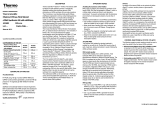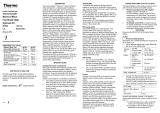Page is loading ...

RevertAid Master Mix
Catalog Number M1631, M1632
Pub. No. MAN0018936 Rev. D.00
Contents and storage
Cat. No.
Contents
Amount
Storage
M1631
20X Enzyme mix (MuLV and RNase inhibitor protein)
50 rxns, 50 µL
-25 °C to -15 °C
2X RT Buffer Mix (dNTPs, random primers, and oligo dT)
500 µL
M1632
20X Enzyme mix (MuLV and RNase inhibitor protein)
100 rxns, 100 µL
2X RT Buffer Mix (dNTPs, random primers, and oligo dT)
1000 µL
Description
Thermo Scientific RevertAid Master Mix is a complete system for efficient synthesis of first strand cDNA from mRNA
or total RNA templates. The kit uses RevertAid Reverse Transcriptase (RT), which has lower RNase H activity
compared to AMV reverse transcriptase. RevertAid Master Mix provides all cDNA synthesis reaction components in
a convenient two-tube master mix. It is optimized for highly efficient cDNA synthesis for two-step quantitative
RT-PCR (RT-qPCR) applications. The two-tube formulation reduces reaction time and requires fewer pipetting steps
than with the RevertAid RT Reverse Transcription Kit, while maintaining high performance.
Procedural guidelines
Avoiding ribonuclease contamination
RNA purity and integrity is essential for synthesis of full-length cDNA. RNA can be degraded by RNase A, which is a
highly stable contaminant found in laboratory environments. General recommendations to avoid RNase
contamination:
Use certified nuclease-free labware or DEPC-treat all tubes and pipette tips to be used in cDNA synthesis.
Wear gloves when handling RNA and reagents, as skin is a common source of RNases. Change gloves
frequently.
Use RNase-free reagents, including high quality water (e.g., Water, nuclease-free, #R0581).
Keep the kit components tightly sealed when not in use. Keep all tubes tightly closed during the reverse
transcription reaction.
Template RNA
The kit is compatible with total cellular RNA isolated by standard methods. Purified RNA must be free of salts, metal
ions, ethanol, and phenol to avoid inhibiting the cDNA synthesis reaction.
For RT-qPCR applications, template RNA must be free of DNA contamination. Prior to cDNA synthesis, treat RNA
samples with DNase I, RNase-free (#EN0521) or dsDNase (#EN0771) to remove residual DNA (See product pages
at www.thermofisher.com for detailed protocols).
Always perform a No RT Control reaction, which includes all components for reverse transcription except the
RevertAid RT.
For Research Use Only. Not for use in diagnostic procedures.
WARNING! Read the Safety Data Sheets (SDSs) and follow the handling instructions. Wear appropriate protective eyewear, clothing, and gloves. Safety Data
Sheets (SDSs) are available from thermofisher.com/support.

RNA sample quality
Assess RNA integrity prior to cDNA synthesis. Total eukaryotic RNA can be analyzed by agarose gel electrophoresis followed
by ethidium bromide staining.
The RNA is considered intact, if both 18S and 28S rRNA appear as sharp bands after electrophoresis of total RNA. The 28S
rRNA band should be approximately twice as intense as the 18S rRNA. Smearing of rRNA bands is an indication of degraded
mRNA, and a new sample of total RNA should be prepared.
Alternatively, total RNA can be analyzed using a bioanalyzer (e.g., Agilent 2100) to obtain an RNA integrity number, which
provides quantitative information about the general state of the RNA sample (2). A reference gene/target gene 3’:5’ integrity
assay (3) can also be used to determine the integrity of the RNA sample.
Primers
RevertAid MM contains oligo dT and random primers to prime synthesis of first strand cDNA. This primer mixture ensures high
sensitivity in low copy number transcript detection assays.
Protocol
Allow kit components to thaw, then mix and briefly centrifuge. Store the tubes on ice.
1. Add the following reagents into a sterile, RNase free tube or plate on ice in the following order:
Component
Volume
total RNA
or poly(A) mRNA
or specific RNA
0.1 ng - 5 μg
10 pg - 0.5 μg
0.01 pg - 0.5 μg
2X RT Buffer Mix
10 µL
20X RT Enzyme Mix
1.0 μL
Water, nuclease-free
to 20 µL
Total volume
20 µL
2. Seal the plates or tubes with the appropriate seal or caps.
3. Briefly centrifuge the plate or tubes to spin down the contents and to eliminate any air bubbles.
4. Place the plate or tubes on ice until you are ready to start the reverse transcription reaction.
5. Incubate the reaction for 42 °C for 30 minutes.
Note: For using lower than 1000 ng of high-quality RNA input, incubation time could be shortened to 15 minutes. For using higher
than 1000 ng of challenging RNA input, incubation for 60 minutes is recommended.
6. Stop the reaction by heating to 95 °C for 5 minutes and hold at 4 °C. For convenience, the incubation may be performed in a
thermal cycler.
The cDNA is ready for use in PCR applications or for storage at -20 °C for less than one week. For longer storage,
-70 °C is recommended.
qPCR
Use the product of the cDNA synthesis reaction directly in qPCR. Normally, 2 µL of the RT product is used as template for
subsequent qPCR in a 25 µL total volume.
Control reactions
Use the following negative control reactions to verify the results of the first strand cDNA synthesis.
No RT control to assess genomic DNA contamination of the RNA sample.
No template control (NTC) to assess for reagent contamination. The NTC reaction includes all reagents necessary for the
reverse transcription reaction except the RNA template.
Prepare control reactions according to the following instructions.
Note: Template RNA amount and reverse transcription incubation conditions should reflect the conditions used for experimental
samples.
1. Add the following reagents into a sterile, RNase free tube or plate on ice in the following order:
Component
No RT control
No template control
total RNA
or poly(A) mRNA
or specific RNA
0.1 ng - 5 μg
10 pg - 0.5 μg
0.01 pg - 0.5 μg
—
2X RT Buffer Mix
10 μL
10 μL
20X RT Enzyme Mix
—
1 µL
Water, nuclease-free
to 20 µL
to 20 µL
Total volume
20 µL
20 µL
2 RevertAid Master Mix

2. Seal the plates or tubes with the appropriate seal or caps.
3. Briefly centrifuge the plate or tubes to spin down the contents and to eliminate any air bubbles.
4. Place the plate or tubes on ice until you are ready to start the reverse transcription reaction.
5. Incubate the reaction for 42 °C for 30 minutes.
Note: For using lower than 1000 ng of high-quality RNA inputs, incubation time could be shortened to 15 minutes. For using higher than 1000
ng of challenging RNA inputs, incubation for 60 minutes is recommended.
6. Stop the reaction by heating to 95 °C for 5 minutes and hold at 4 °C. For convenience, the incubation may be performed in a
thermal cycler.
Troubleshooting
No qPCR product generated or product appears late in qPCR
Poor integrity of RNA template
RNA purity and integrity is essential for synthesis and quantification of cDNA.
Always assess the integrity of RNA prior to cDNA synthesis.
Use freshly prepared RNA.
Multiple freeze/thaw cycles of the RNA sample and synthesized cDNA is not recommended.
Follow general recommendations to avoid RNase contamination and discard low quality RNA.
Low template purity (inhibitors in RNA sample)
Trace amounts of agents used in RNA purification protocols may remain in solution and inhibit first strand synthesis (e.g., SDS, EDTA,
guanidine salts, phosphate, pyrophosphate, polyamines, spermidine).
Remove trace contaminants by re-precipitating the RNA with ethanol and wash the pellet with 75 % ethanol.
Insufficient template quantity
Increase the amount of RNA template in the first strand reaction to the recommended level.
GC-rich template
If the RNA template is GC-rich or is known to contain secondary structures, the temperature of the reverse transcription reaction can be
increased up to 45 °C.
Excess amount of cDNA in qPCR
Decrease amount of cDNA synthesis reaction in qPCR.
The volume of the cDNA synthesis reaction mixture should not exceed 10 % of the final PCR reaction mixture.
RT-qPCR product in No RT Control
RNA template is contaminated with DNA.
The presence of a PCR product in the negative control (No RT Control) reaction indicates that the reaction is contaminated with DNA.
Follow the protocol carefully and make sure that dsDNase treatment step prior reverse transcription is not omitted. To further enhance
genomic DNA elimination efficiency, template RNA incubation with dsDNase step can be prolonged to 5 minutes.
References
1. Wiame, I., et al., Irreversible heat inactivation of DNaseI without RNA degradation, BioTechniques, 29, 252-256, 2000.
2. Fleige, S., Pfaffl, M.W., RNA integrity and the effect on the real-time qRT-PCR performance, Mol. Aspects Med., 27, 126-139, 2006.
3. Nolan, T., et al., Quantification of mRNA using real-time RT-PCR, Nat. Protoc., 1, 1559-1582, 2006.
Limited product warranty
Life Technologies Corporation and/or it affiliate(s) warrant their products as set forth in the Life Technologies’ General Terms and Conditions
of Sale at www.thermofisher.com/us/en/home/global/terms-and-conditions.html. If you have any questions, please contact Life
Technologies at www.thermofisher.com/support.
The information in this guide is subject to change without notice.
DISCLAIMER: TO THE EXTENT ALLOWED BY LAW, THERMO FISHER SCIENTIFIC INC. AND/OR ITS AFFILIATE(S) WILL NOT BE LIABLE FOR SPECIAL, INCIDENTAL, INDIRECT,
PUNITIVE, MULTIPLE, OR CONSEQUENTIAL DAMAGES IN CONNECTION WITH OR ARISING FROM THIS DOCUMENT, INCLUDING YOUR USE OF IT.
Important Licensing Information: These products may be covered by one or more Limited Use Label Licenses. By use of this product, you accept the terms and conditions of all
applicable Limited Use Label Licenses.
©2021 Thermo Fisher Scientific Inc. All rights reserved. All trademarks are the property of Thermo Fisher Scientific and its subsidiaries unless otherwise specified.
hermofisher.com/support | thermofisher.com/askaquestion
thermofisher.com
Thermo Fisher Scientific Baltics UAB | V.A. Graiciuno 8, LT-02241 Vilnius, Lithuania
For descriptions of symbols on product labels or product documents, go to thermofisher.com/symbols-definition.
19 May 2021
/









